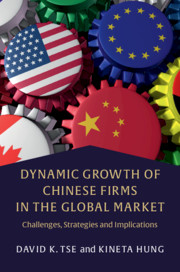Book contents
- Dynamic Growth of Chinese Firms in the Global Market
- Dynamic Growth of Chinese Firms in the Global Market
- Copyright page
- Contents
- Figures
- Tables
- 1 Introduction
- 2 China’s Economic Rise and Global Footprints of Chinese Firms
- 3 Globalisation of Chinese Firms Using Existing Paradigms
- 4 Globalisation of Chinese Firms Using New Paradigms
- 5 Challenges and Failures
- 6 Product Images and Market Acceptance of Chinese-Made Products
- 7 Corporate Social Responsibility
- 8 Managing National Image
- 9 China’s Technological Competence, Trade Relations, and Economic Co-operation
- 10 Holistic Conclusion through a Futuristic Lens
- Index
- References
10 - Holistic Conclusion through a Futuristic Lens
Published online by Cambridge University Press: 05 February 2020
- Dynamic Growth of Chinese Firms in the Global Market
- Dynamic Growth of Chinese Firms in the Global Market
- Copyright page
- Contents
- Figures
- Tables
- 1 Introduction
- 2 China’s Economic Rise and Global Footprints of Chinese Firms
- 3 Globalisation of Chinese Firms Using Existing Paradigms
- 4 Globalisation of Chinese Firms Using New Paradigms
- 5 Challenges and Failures
- 6 Product Images and Market Acceptance of Chinese-Made Products
- 7 Corporate Social Responsibility
- 8 Managing National Image
- 9 China’s Technological Competence, Trade Relations, and Economic Co-operation
- 10 Holistic Conclusion through a Futuristic Lens
- Index
- References
Summary
Twenty-five years after Chinese firms began their globalisation process, some of them have become global game changers and represented in the Fortune Global 500. This chapter begins by discussing the nature, types, and extent of changes these firms have brought about. Then, the chapter points out the growing challenges, including the challenges posed by Chinese firms’ overseas operations and merger and acquisition activities that would affect the perceptions of these firms in the international market. The third part of the chapter takes a futuristic lens and proposes how ‘Chinese firms going global’ will evolve, including a discussion on the extent the world accepts globalising Chinese firms and the impact world acceptance may pose on these firms’ future and growth.
Keywords
- Type
- Chapter
- Information
- Dynamic Growth of Chinese Firms in the Global MarketChallenges, Strategies and Implications, pp. 193 - 214Publisher: Cambridge University PressPrint publication year: 2020

